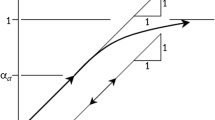Abstract
A mathematical model for the prediction of volume change cracking in end-restrained concrete members has been developed. The model adopted the ACI Committee 209 method for the prediction of creep and shrinkage of concrete in conjunction with the bond slip cracking mechanism with an improved tensile strain distribution. The time discretization method was used for calculating the development of shrinkage and creep in concrete, taking into consideration the daily variations in temperature and relative humidity. Before-cracking and after-cracking creep of concrete were also calculated, for the first time, taking into consideration the variable stress level to which the concrete section is exposed.
The results of tensile strain development, cracking age and crack width development obtained from the proposed model were compared with those obtained from a previous experimental research program which used a test model that largely resembled site conditions. The two results were found to be in line with one another, which proves the feasibility of the proposed model.
Résumé
On a élaboré un modèle mathématique pour la prédiction de la fissuration due au changement de volume des éléments en béton encastrés sur leurs extrémités. Ce modèle adopte la Méthode ACI 209 pour la prédiction du fluage et du retrait du béton conjugés au mécanisme de fissuration due à la défaillance de l'adhérence avec une amélioration de la distribution de la résistance à la traction. Le calcul du développement du retrait et du fluage a été fait en fonction du temps et a tenu compte des variations de température et d'humidité relative. Le fluage, avant et après fissuration, a été calculé également, en tenant compte, pour la première fois, du niveau de contrainte variable auquel est exposé l'élément en béton.
Les résultats obtenus de ce modèle proposé sur le développement de la contrainte de traction, l'âge de fissuration et le développement en largueur des fissures ont été comparés à ceux provenant d'une recherche expérimentale précédente utilisant un modèle d'essai, qui ressemble aux conditionsin situ. Les deux méthodes ont donné des résultats concordants, ce qui valide le modèle proposé.
Similar content being viewed by others
References
ACI Committee 209, ‘Prediction of Creep, Shrinkage and Temperature Effects in Concrete Structures’ (ACI209R-82) (American Concrete Institute, Detroit, 1982) 92 pp.
Vetter, C.P. ‘Stresses in reinforced concrète due to volume changes’, Transactions,American Society of Civil Engineers 98 (1933) 1039–1053.
Evans, E.P. and Hughes, B.P., ‘Shrinkage and thermal cracking in a reinforced concrete retaining wall’, in Proceedings, Institute of Civil Engineers (London), V. 39, Jan. 1968, 111–125.
Al Rawi, R.S. and Al Qassab, F.F., ‘Control of Shrinkage Cracking in Continuously Reinforced Concrete Pavements’, presented at the ACI Fall Convention, Vancouver, Canada. Sept. 1986.
Al Ali, B.T., ‘Control of Shrinkage Cracking in Reinforced Concrete’, M.Sc. Thesis, University of Baghdad, 1986.
Base, G.D. and Murray, M.H., ‘A new look at shrinkage cracking’, Civil Engineering Transactions (Barton), V.CE24, No. 2, May 1982, 171–176.
Kheder, G.F., Al Rawi, R.S. and Al Dhahi, J.K., ‘A study of the behaviour of volume change cracking in base restrained concrete walls’,Mater. Struct. 27 (1994) 383–392.
Smerda, Z. and Kristek, V. ‘Creep and Shrinkage of Concrete Elements and Structures’ (Elsevier, Czechoslovakia, 1988) 296 pp.
Tam, K.S.S. and Scanlon A., ‘Analysis of cracking due to restrained volume change in reinforced concrete members’,ACI Journal Proceedings,69 (4) (1986) 658–667.
Gopalaratnam, V.S. and Shah, S.P., ‘Softening response of plain concrete in direct tension’,ACI Journal Proceedings 82 (3) (1985) 310–323.
Al Rawi, R.S. and Kheder G.F., ‘Control of cracking due to volume change in base restrained concrete members’,ACI Journal Proceedings 87 (4) (1990) 397–405.
Author information
Authors and Affiliations
Rights and permissions
About this article
Cite this article
Kheder, G.F. A mathematical model for the prediction of volume change cracking in end-restrained concrete members. Mat. Struct. 30, 174–181 (1997). https://doi.org/10.1007/BF02486390
Issue Date:
DOI: https://doi.org/10.1007/BF02486390




